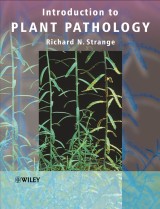Details

Introduction to Plant Pathology
1. Aufl.
|
87,99 € |
|
| Verlag: | Wiley |
| Format: | |
| Veröffentl.: | 08.02.2006 |
| ISBN/EAN: | 9780470869536 |
| Sprache: | englisch |
| Anzahl Seiten: | 480 |
DRM-geschütztes eBook, Sie benötigen z.B. Adobe Digital Editions und eine Adobe ID zum Lesen.
Beschreibungen
<p>This invaluable resource introduces the eleven types of organism that cause plant disease, ranging from higher plants to viroids and describes examples of cash and staple crop diseases that have caused human catastrophes. Early chapters cover serological and molecular techniques for the diagnosis of plant pathogens, epidemiology, methods for estimating disease severity and its effect on crop yields and techniques for limiting inoculum. Later chapters are concerned with colonisation of the plant and symptom development and the underlying biochemical and genetic factors that control these events. Finally, the control of plant disease using a variety of techniques including genetic modification is discussed.</p> <ul> <li>Modern diagnostic techniques</li> <li>Epidemiology and the measurement of disease severity</li> <li>The biochemistry and molecular biology of plant disease</li> <li>Control through cultural, biological, genetic and molecular techniques</li> <li>A wealth of examples and applications including full colour photographs</li> </ul>
Preface. <p>1. The Causal Agents of Plant Disease: Identity and Impact.</p> <p>2. The Detection and Diagnosis of Plant Pathogens and the Diseases They Cause.</p> <p>3. Epidemiology.</p> <p>4. The Measurement of Inoculum and Disease Severity and Their Effect on Crop Yields.</p> <p>5. Inoculum Control.</p> <p>6. Locating, Penetrating and Colonising the Host.</p> <p>7. Subverting the Metabolism of the Host.</p> <p>8. Killing the Host—the Role of Toxins.</p> <p>9. The Plant Fights Back—1. Constitutive Defence Mechanisms.</p> <p>10. The Genetics of Compatibility and Incompatibility.</p> <p>11. The Plant Fights Back—2. Active Defence Mechanisms.</p> <p>12. Control of the Disease Process.</p> <p>Epilogue.</p> <p>Glossary.</p> <p>References.</p> <p>Index. </p>
"...is clearly written, comprehensive, and timely...a valuable addition to the literature on plant pathology..." (Israel Journal of Plant Sciences, vol. 51) <p>"...well composed with many figures...can be well recommended to students and young researchers..." (Journal of Plant Physiology, Vol 161, 2004)</p> <p>"... provides a comprehensive coverage...illustrated by many examples.." (EPPO Reporting Service, 1st July 2004. No. 06)</p> <p>"...excellent glossary and index...over 1000 references...I fully recommend its purchase..." (Plant Pathology, Vol. 53, No.5, October 2004)</p> <p>"...recommended..." (Phytopathology, Vol 153 (126) 2005)</p>
<b>RICHARD STRANGE</b> is Senior Lecturer in Plant Pathology at University College London and has a special interest in the plant disease problems of developing countries. He has written an earlier book <i>Plant Disease Control: Towards Environmentally Acceptable Methods.</i>
Introduction to Plant Pathology provides an integrated coverage of the biology of plant disease, highlighting the organisms that cause such diseases and the techniques used for their identification and control. It is a comprehensive, up-to-date introduction to the subject, including the latest relevant molecular and genetic developments. <p>Broadly divided into two parts, the text opens by placing plant disease in context, showing how disease may cause a catastrophic loss of crops. Pathogens are then discussed alongside epidemiology and the measurement of disease severity and its relation to yield and inoculum control. The second part examines host-pathogen interactions and symptoms caused by altered plant growth regulator metabolism. Finally, the book looks at how the health of crops may be improved through the continuing development of control measures that are environmentally responsible.</p> <ul> <li>An accessible introduction, including coverage of the molecular biology of plant disease.</li> <li>Includes many examples and applications throughout, along with full colour photographs.</li> <li>A diverse selection of case studies provided along with a detailed glossary</li> </ul>

















